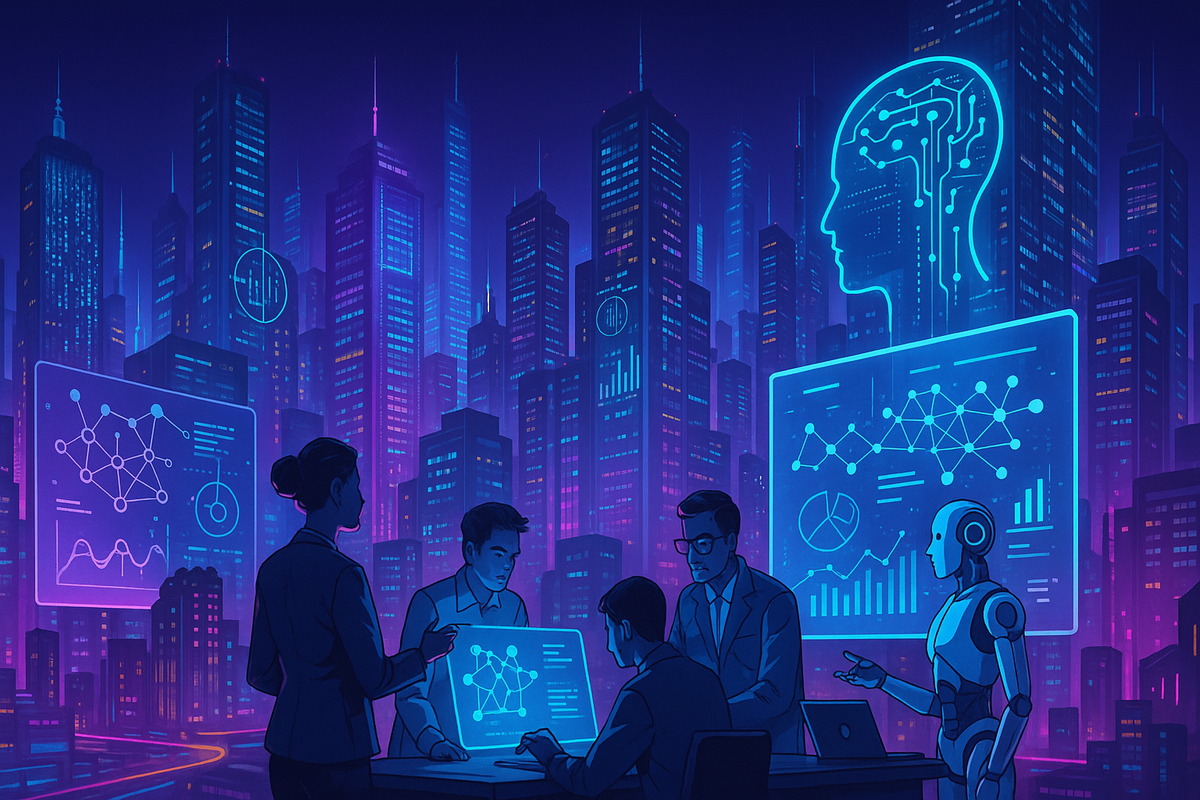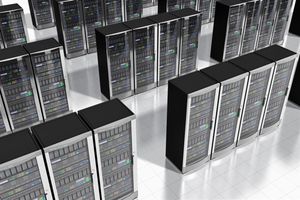
The world's leading technology companies are currently engaged in an unprecedented spending spree on Artificial Intelligence (AI), with significant immediate and long-term implications for the market and public companies. This "spending spree" is characterized by massive capital expenditures aimed at building the foundational infrastructure necessary for advanced AI development and deployment.
In 2025, major technology companies have collectively invested an estimated $155 billion in AI development and infrastructure. This figure notably surpasses the US government's spending on education, training, employment, and social services for the same fiscal year. This aggressive investment signals a profound shift in the tech landscape, as companies race to dominate the burgeoning AI frontier, anticipating that these substantial outlays will be rewarded with significant market gains and competitive advantages.
The AI Arms Race: What Happened and Why It Matters
The current surge in AI investment is a direct response to the rapid advancements and perceived transformative potential of artificial intelligence. Companies are pouring billions into building and upgrading massive data centers, which are the physical backbone for training and deploying sophisticated AI models and supporting extensive cloud services. This infrastructure demands significant power, water, and, crucially, expensive semiconductor chips.
Key players and their substantial capital expenditures (capex) highlight the scale of this commitment:
- Amazon (NASDAQ: AMZN) reported $55.7 billion in capex for the first two quarters of the current fiscal year, with an estimated total expenditure of $100 billion for 2025, potentially reaching $118 billion.
- Alphabet (NASDAQ: GOOGL), Google's parent company, reported nearly $40 billion in capex for the first two quarters and plans to spend $85 billion in 2025, a significant increase from its previous estimation of $75 billion.
- Meta (NASDAQ: META) saw its year-to-date capex amount to $30.7 billion, doubling the figure from the same period last year. For the most recent quarter alone, Meta spent $17 billion on capital expenditures, and the company plans to spend between $66 billion and $72 billion in 2025.
- Microsoft (NASDAQ: MSFT) plans to spend over $30 billion in the current quarter to build out data centers for its AI services, with its CFO indicating that current quarter capex would be at least 50% more than the outlay during the same period a year earlier. Microsoft intends to invest approximately $100 billion in AI in the next fiscal year.
- Apple (NASDAQ: AAPL), while typically more reserved, has also signaled a substantial increase in AI spending, with its quarterly capex rising to $3.46 billion, up from $2.15 billion during the same period last year.
This unprecedented investment is driven by the belief that AI will be the next major technological paradigm shift, akin to the internet or mobile computing. Companies are vying for leadership in generative AI, large language models, and AI-powered cloud services, recognizing that early and aggressive investment could secure long-term market dominance. The initial market reaction has been largely positive, with Wall Street rewarding these aggressive strategies, as evidenced by soaring stock prices for many of these tech giants.
The AI Dividend: Winners and Losers in the New Era
The massive influx of capital into AI is creating clear winners and potential losers across the technology landscape and beyond. The most immediate beneficiary is undoubtedly the semiconductor industry, particularly companies specializing in high-performance AI chips.
Nvidia (NASDAQ: NVDA) stands out as a dominant winner. As the leading provider of the Graphics Processing Units (GPUs) essential for training and deploying complex AI models, Nvidia has seen unprecedented demand for its products. Its stock has surged, reflecting its critical role in enabling the AI revolution. Other chipmakers and hardware providers, such as Advanced Micro Devices (NASDAQ: AMD) and Taiwan Semiconductor Manufacturing Company (NYSE: TSM), are also poised to benefit from the increased demand for AI-specific hardware.
Among the Big Tech giants, the picture is more nuanced. Microsoft (NASDAQ: MSFT) and Alphabet (NASDAQ: GOOGL) have demonstrated strong performance in their cloud computing divisions, Azure and Google Cloud respectively, which are directly benefiting from the demand for AI infrastructure and services. Their aggressive AI investments are already translating into tangible revenue growth, particularly in their cloud offerings and search capabilities. Microsoft's market capitalization hitting $4 trillion underscores investor confidence in its AI strategy.
However, not all major players are experiencing uniform success. Amazon's (NASDAQ: AMZN) cloud division, Amazon Web Services (AWS), while still a market leader, has underperformed investor expectations in some recent quarters. This has led to a stock drop and anticipated margin pressure through 2026, as the company grapples with the immense costs of building out its AI infrastructure. This highlights the challenge of translating massive capital expenditures into immediate, proportional returns.
Beyond the tech giants, companies that can effectively integrate AI into their products and services, or those that provide essential components for AI development (like specialized software, data management tools, or energy solutions for data centers), are likely to emerge as winners. Conversely, companies that fail to adapt or invest in AI, or those whose business models are disrupted by AI-powered solutions, risk falling behind. The high failure rate of AI projects, with over 80% failing to deliver meaningful returns, also poses a significant risk for companies making these substantial bets.
Industry Impact and Broader Implications
The "Big Tech AI Spending Spree" is not merely a financial event; it represents a fundamental reshaping of the technology industry and carries broader societal and economic implications. This investment wave fits squarely into the ongoing trend of digital transformation, but at an accelerated and unprecedented scale.
The most significant ripple effect is on the competitive landscape. The immense capital required to compete in the AI arms race creates substantial barriers to entry for smaller players and startups. This could lead to increased market concentration, with a few dominant tech giants controlling the vast majority of AI infrastructure and capabilities. This raises critical questions about competition, innovation, and the potential for monopolistic practices within the AI supply chain. Regulators worldwide are already scrutinizing the expanding influence of Big Tech, and this AI investment surge is likely to intensify calls for antitrust measures and policy interventions to ensure a level playing field.
Economically, the surge in AI infrastructure spending is projected to have a noticeable impact on GDP. Morgan Stanley estimates that this investment could add up to 0.5% to U.S. GDP growth in 2025 and 2026. The Washington Post estimates that the top four tech companies' $350 billion in AI spending could lift U.S. GDP by 0.7% in 2025. However, this growth comes with a caveat: the immense spending on chips, data centers, and other AI infrastructure is also draining American corporations of cash and straining capital markets, potentially leading to increased borrowing and financial leverage. Some analysts even raise concerns about the massive AI data center boom potentially creating the next financial bubble, drawing parallels to the dot-com crash, especially with the increasing reliance on private credit funding for these centers.
Furthermore, the environmental implications are significant. The new data centers are massive energy consumers, requiring substantial amounts of power and water. This raises concerns about their carbon footprint and strain on natural resources. Consequently, there's a surging investment in renewable power and storage solutions to meet this new demand, creating opportunities for companies in the clean energy sector.
Finally, the job market faces profound changes. The adoption of generative AI has already led to significant layoffs in the tech sector, with thousands of job cuts explicitly linked to AI automation. While AI is expected to create new jobs and industries, the immediate impact raises questions about whether AI will create more disruption than opportunity in the broader job market, necessitating significant reskilling and upskilling initiatives.
What Comes Next
The current AI spending spree is merely the opening act of a much larger transformation. In the short term, we can expect the "AI arms race" to intensify, with companies continuing to pour hundreds of billions more into infrastructure and research. Projections indicate that the collective spending by Microsoft, Amazon, Alphabet, and Meta on AI-related infrastructure could reach $344 billion in 2025, with some analysts pushing global AI buildout estimates toward $500 billion annually. Long-term forecasts from Bloomberg Intelligence project that Microsoft, Amazon, and Meta alone will spend $525 billion on AI infrastructure by 2032, and Morgan Stanley forecasts a staggering $2.9 trillion in AI infrastructure spending between 2025 and 2028.
This sustained investment will drive further innovation in AI models, leading to more sophisticated and capable applications across various industries. We can anticipate a proliferation of AI-powered products and services, from enhanced customer service and personalized experiences to advanced scientific research and autonomous systems. Companies that can effectively integrate these AI capabilities into their core business operations will gain a significant competitive edge.
However, this aggressive pursuit of AI dominance also presents challenges. Companies will face increasing pressure to demonstrate tangible returns on their massive investments. The current enthusiasm on Wall Street will eventually demand concrete evidence of profitability and sustainable growth driven by AI. This may lead to strategic pivots, with companies refining their AI strategies to focus on areas with clearer revenue generation potential.
Market opportunities will emerge for companies providing specialized AI services, ethical AI solutions, and robust cybersecurity measures to protect AI systems. Challenges will include managing the immense energy demands of AI infrastructure, navigating evolving regulatory landscapes, and addressing the societal impact of AI on employment and privacy. Potential scenarios range from a sustained period of AI-driven economic growth and innovation to a more volatile environment marked by intense competition, regulatory hurdles, and the potential for an "AI bubble" if investments outpace real-world applications and profitability.
Conclusion
The "Big Tech AI Spending Spree" is a defining moment in the history of technology and finance. The unprecedented $155 billion investment in AI this year, with expectations for hundreds of billions more, underscores the profound belief that AI is the next frontier of innovation and economic growth. While this aggressive capital deployment is fueling significant revenue growth and boosting stock valuations for many tech giants, it also introduces a complex web of challenges and risks.
Key takeaways include the immense scale of investment, the critical role of infrastructure in AI development, and the uneven distribution of benefits among companies. While chipmakers like Nvidia (NASDAQ: NVDA) and cloud leaders like Microsoft (NASDAQ: MSFT) and Alphabet (NASDAQ: GOOGL) are currently thriving, others like Amazon (NASDAQ: AMZN) face margin pressures. The broader implications extend to market concentration, potential economic bubbles, environmental concerns, and significant shifts in the job market.
Moving forward, investors should closely watch several key indicators. The ability of companies to translate their massive AI investments into sustainable, profitable revenue streams will be paramount. Monitoring the development of regulatory frameworks around AI, particularly concerning competition and data privacy, will also be crucial. Furthermore, the progress in developing more energy-efficient AI infrastructure and renewable energy solutions will be vital for the long-term sustainability of this technological revolution. The coming months will reveal whether this colossal bet on AI will deliver the transformative returns anticipated or if it will lead to unforeseen challenges in the pursuit of an AI-powered future.







